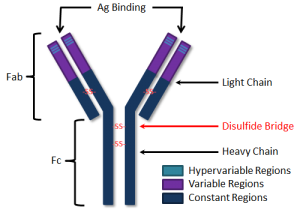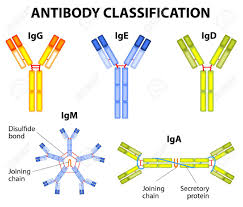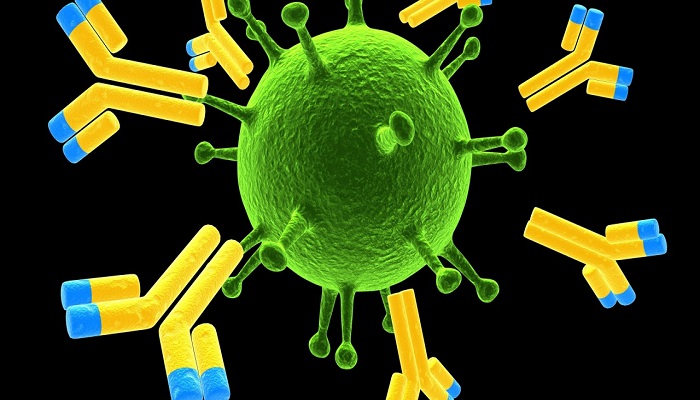Immunoglobulins (Ig) or antibodies (Ab) are glycoprotein molecules produced by the plasma cells in response to immunogen that may be any foreign particle. These are called as immunoglobulins as they consist of globular proteins in their structure.
Basic structure of immunoglobulin
Each immunoglobulin molecule consists of four polypeptide chains in which two are light and the other two chains are heavy chains. In these polypeptide chains the amino terminal may have variations in their amino acid sequence so these are variable regions of antibody molecule while the remaining part is relatively constant in its amino acid sequence.
Heavy and light chains
Each of the light chains contains a constant domain CL (110 amino acids) and the other variable domain VL (110 amino acid monomers) . Similarly the heavy chains also consists of a variable (110 amino acids) and three constant domains (330-440 amino acids) namely CH1, CH2 & CH3 domains. Approximately, the molecular weight of antibody is 150000 Da while the individual light chain has molecular weight of 25000 and each heavy chain has 50000 Da molecular weight.
Disulphide bonds
There are inter chain disulphide bonds present between heavy and light chains and also between the two heavy chains and their number varies among different classes of immunoglobulins. Also intra chain disulphide bonds are present within each polypeptide chains. The Y-shape of antibody consists of a hinge region at which the molecule shows some degree of flexibility. Oligosaccharides are bound to CH2 domain of most of antibody molecule.

Antigen binding fragment
Antigen Binding Fragments (Fab) of antibody are called Fab (fragment antigen binding region) that is monovalent compared to the original divalent molecule. Both the CL and VL constitute the binding site of antibody that is essential as it allows the antibody to bind to a specific antigen. Changing the VL and CL regions sequence affects the antigen binding capacity of immunoglobulins.
Fragment constant region
Fragment Constant (FC) region is the part of antibody molecule that has relatively constant amino acid sequence for the particular class of antibody.
The variable region of antibody structure further consists of these components:
Complimentarity determining region/ hypervariable region
The variability of amino acids resides mainly in regions of antibody structure – the hyper variable regions (HVR). Complimentarity region of antibody is its binding site and are present in both light and heavy chains of its structure. The regions in between the complimentarity parts are termed as framework regions.
General functions of immunoglobulins
- Antigen binding: one of the most important functions of antibodies is that they bind to a particular antigen so that the cells of body’s immune system are able to detect them and then generate specific immune responses to clear them out.
- Effector functions that depend upon binding of antigen to antibody molecule.
- Compliment fixation that is because of secretion of certain complementarity proteins in response to cell damage.
- Binding to receptors cells: Cells of immune systems have receptors that bind to these antigen-carrying antibodies which may activate these cells to perform certain functions.
Various classes of immunoglobulins
Based upon the difference in amino acid sequence of constant region of antibody molecule, they are categorized into five classes.
- IgA (α chain containing antibody )
- IgG (gamma chain)
- IgE (epsilon chain )
- IgM (mu chain)
- IgD (delta chains)
1. IgA class of immunoglobulin
Structure of IgA
This type of immunoglobulin is found in milk, sweat, tears and saliva and some other secretions. IgA of serum has monomeric structure while those present in other secretions are in the form of dimer in which a J-chain is associated with the antibody structure. It contains four antigen binding sites. A secretary piece of protein “T-piece” is also associated with it that is formed in epithelial cells and is associated with the antibody when it is passed into body secretions.
The purpose of this secretion is to help transport of antibody and its prevention from degradation. The molecular weight of igA is 320000 Da and its conc. In serum is usually in between 1-4 mg/ml that comprise about 15% of total antibody conc. In body.
Sub classes of IgA
IgA1 and igA2 are two sub classes of this class. The former is synthesized in bone marrow and the later in MALT of B-cells. These antibodies are active against certain pathogenic bacteria and activate an alternative complimentary pathway of immune system activation.
Functions & properties
- IgA is a secretary type of antibody class and is widely distributed in body’s secretions.
- It is active against the pathogens that are responsible for gastrointestinal and respiratory infections.
- As source of passive immunity in newborns as these antibodies can cross the placental membrane and support the immune system of newborn.
- Active in recognition of gram negative pathogenic bacteria species.
- Poly-Ig receptor helps in transport of IgA type immunoglobulins.
- They can bind to certain lymphocytes and PMN’s cells of immune system to stimulate them to get activated and produce immune response.
2. IgG class of immunoglobulin
Structure Of IgG
The most abundant class of antibody that comprises about 80% of total immunoglobulin concentration in body. This class of antibody is also monomeric and the subclasses are based upon the hinge region and the number of disulphide bonds in structure. Total antigen binding sites are two. Molecular weight of total chains of antibody structure is approximately 150000 Da.
IgG production is the secondary or delayed response of immune system. So this type of antibodies is significant for passive immune response. The fragment constant part of antibody can enter the fetal circulation through placenta that provides protection to fetal. They require the FC receptors of IgG on surface of cells of immune system such as macrophages, natural killer cells and neutrophils so they can activate the compliment system. The IgG attachment to these cells activates the process of opsonization in which the cells of immune system engulf the pathogens or the foreign particles coated with IgG.
Sub classes of IgG
Mammals such as humans, rats, mice etc contain sub classes of IgG. These subclasses are:
- IgG-1: This constitute about 65% o total igg conc. These antibodies generate thymus mediated immune responses when they recognize the polypeptide or protein as foreign particle. Binding of igG-1 activates compliment cascade in phagocytic cells.
- IgG-2: It recognizes the polysaccharide antigens and it constitute about 20-25% of igg concentration. This subclass of antibody cannot cross the placental barrier.
- Subclasses igG-3 and igG-4 also recognizes similar antigens and generate similar responses but igg-4 cannot activate the compliment cascade.
Functions & properties
- Most abundant class of antibody that also provides a longer time period of passive immunity and this also provide neonatal immunity as they can cross the placental barrier except few sub classes. The neonatal intestine has the receptors for these antibodies.
- After they recognize the antigen, the macrophages and killer cells engulf them and kill the pathogens by opsonization that basically damages the pathogen’s cell membrane.
- For particulate antigen, they develop agglutination while the others are responsible for precipitation reactions.
- These antibodies basically recognize the toxins and the polysaccharide component of bacterial cells and also they inhibit the adherence of viral particles to target cells.
3. IgE class of immunoglobulin
Structure of IgE
Ishizaka discovered this class of immunoglobulins in 1966. These are located on basophils and mast cells of immune system and comprises of less than 0.1% of total immunoglobulins.
In its structure, the heavy chain contains an extra domain that assists its binding to FC region of epsilon receptors of basophils, mast cells and eosinophils. Antibodies recognize pollens, spores, dust particles as antigens.
After the bonding of antigen, these immunoglobulins signal the cells to which its receptors are attached and the result is that the cells degranulate and release allergic factors. These factors are chemicals such as leukotrienes, histamine, cytokines and heparins. Vasodilatation cause leakage of fluid form tissues that generate symptoms of allergy like cough, sneezing etc. Their purpose is to remove the allergens from body. In case of parasitic infections, the increased level of ige activates eosinophils that bind to receptors of parasitic cell surface and they cause death of parasite.
Functions & properties
- They are heat liable immunoglobulins
- High temperature up to 56 degree deactivate these
- Their function is to mediate hypersensitivity reactions (anaphylaxis). Kustner and Prausnitz demonstrated these hypersensitivity reactions in year 1921. This proved that binding of antigen to these IgE and activation of immune cells by them results in production of pharmacological mediators that generate allergic responses.
- They do not activate the compliment system but generate inflammatory responses.
4. IgM class of immunoglobulin
Structure of IgM
This immunoglobulin molecule is combination of five monomeric antibodies. Their constant region join together and make a petameric structure as a whole. So this is the largest antibody in size. J-chain holds all the subunits together by disulphide bond and mu chain has an extra domain in its structure. This class of antibodies constitutes about 10% of total immunoglobulins. Overall, its structure has ten binding sites for antigens so its helps in agglutination reactions. The plasma cells synthesize these immunoglobulins in response to infection. Also it is present in B-cells in monovalent form as receptor.
The surface IgM is a monomeric structure without a J chain but it contains some 20 additional amino acids at C-termini that aid anchorage to cell membrane and it contains two additional protein sequences named as Ig α and β on B-cell’s membrane. These protein chains have the role of transducing signal molecules which is because the cytoplasmic tail of B cells cannot act as transducing signal. The attachment of antigens with the IgM molecule initiates the transducing signal that activates B cells. In some cases, B cell activation requires secondary signals of T-cells.
This is present in serum and lymph and the first type of immunoglobulin to be synthesized in fetus. This antibody is more active than igg in recognition of bacterial antigens and activates opsonization to remove them but less active when it comes to viruses and toxin antigens.
Functions & properties
- Third most abundant immunoglobulin.
- Molecular weight is 900,000 Da and its serum concentration is between 0.5-2 mg/ml.
- The very first calls of antibodies to be produced in foetus and in mature B cells a s well.
- Active against the bacterial antigens and cause compliment fixation. Compliment fixation is activation of antibody molecule when it binds with the antigen molecule and it lead to clumping and agglutination reactions.
- The antigen containing antibody binds to Fc receptors of immune cells.
- Primitive type of antibody as found in primitive vertebrate species.
- This type of antibody is for T-cell independent antigens that some antigens when bind to IgM activates B cells directly.
- Cannot cross the placental barrier
- Involves in compliment fixation.
5. IgD class of immunoglobulin
Structure of IgD
These immunoglobulins are monovalent and mainly present on the surface of B cells of immune system as the receptors of certain antigens. It constitutes only 0.2% of immunoglobulin concentration in body.
Functions & properties
- Its molecular weight is 180000 Da
- Serum concentration is 0-0.4mg/ml.
- The structure is monomeric and glycosylated.
- Mainly present on B cell surface and lymphocytes.
- Those igd present on surface of B cells have an extra amino acid that aids its anchorage to cells.
- The actual function of these immunoglobulins in still unclear
- Not involved in compliment fixation.

Bottom line
Human immune system secret various types of immunoglobulin molecules in response to antigens. Each type of immunoglobulin has specificity for antigen binding and these produce stable and lasting immune response in body against pathogens.

